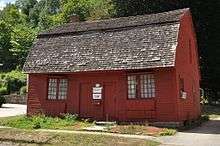Joseph Carpenter Silversmith Shop
The Joseph Carpenter Silversmith Shop is a historic building that was built between 1772 and 1774 on the green in Norwichtown, now a section of Norwich, Connecticut. It is a 30 feet (9.1 m) by 24 feet (7.3 m) 1 1⁄2-story clapboarded building with a gambrel roof. The interior has a single brick chimney that was used for the forge, but it has been modified and adapted for modern use with modern doors, electric lighting and heat, and a disappearing overhead stairway that leads to the attic. Joseph Carpenter (1747–1804) was a successful of silversmith, clockmaker, and pewterer, and shared the building with his brother, a merchant. The shop was added to the National Register of Historic Places on October 6, 1970, and was listed as a contributory property for the Norwichtown Historic District on January 17, 1973.
Joseph Carpenter Silversmith Shop | |
.jpg) Joseph Carpenter Silversmith Shop in 1961 | |
  | |
| Location | 71 E. Town St., Norwich, Connecticut |
|---|---|
| Coordinates | 41°32′59″N 72°5′43″W |
| Area | 0.5 acres (0.20 ha) |
| Built | 1772 |
| Part of | Norwichtown Historic District (ID730019751) |
| NRHP reference No. | 70000722[1] |
| Significant dates | |
| Added to NRHP | October 6, 1970 |
| Designated CP | January 17, 1973 |
Original occupants
Born in 1747 to Joseph and Elizabeth Carpenter (née Lathrop), Joseph Carpenter was a successful silversmith in Norwich, Connecticut. The shop was constructed between 1772 and 1774 and Joseph shared it with his brother Gardner Carpenter, who operated a mercantile business from the shop. In 1775, Joseph Carpenter married Eunice Fitch, and they had six children. He died in 1804.[2] Carpenter was noted to be one of the "most successful of the Norwich silversmiths, clockmakers and pewterers..."[2]
Design

Facing southeast on the Norwichtown green, the Joseph Carpenter Silversmith Shop is a 30 feet (9.1 m) by 24 feet (7.3 m) 1 1⁄2-story clapboarded building with a gambrel roof. Constructed between 1772 and 1774, the building was built on a stone foundation and has a stone stoop leading to the front entrance. The gambrel roof is framed without a ridge pole. It overhangs the front and back facades by 2 feet (0.61 m), but does not project the sides. At the time of the National Historic Register of Places nomination, the roof used wooden shingles.[2] The interior has a single brick chimney that was used for the forge. The main floor was originally open, with only a single supporting post in the center, but this was later partitioned into several rooms. Modern additions to the shop include modern doors, electric lighting and heat, and a disappearing overhead stairway that leads to the attic. The shop's cellar was not described in the survey.[2] In 1915, the house passed out of the Carpenter family, and it was restored by Norman Isham in 1916.[2] In 1956, the building came into the ownership of the "Society of the Founders of Norwich, Connecticut, Inc.". According to the 1966 edition of Fodor's Modern Guides, the Joseph Carpenter Silversmith Shop was "still furnished as it was when Mr. Carpenter plied his trade."[3] The National Historic Register of Places noted that the partitioning was "recent" at the time of its 1970 nomination.[2] In 1997, a $5000 grant was used to replace the roof.[4]
Importance
The Joseph Carpenter Silversmith Shop is an example of a small frame silversmith's shop, and is believed to be the only surviving example in New England. The shop was added to the National Register of Historic Places on October 6, 1970 and it was listed as a contributory property for the Norwichtown Historic District on January 17, 1973.[2][5] As early as 1917, the shop was the subject of a preservation effort.[6] The shop was photographed by the Historic American Buildings Survey. The shop was featured as part of a historic house tour in 1993's "Reflections on the Past."[7]
See also
- National Register of Historic Places listings in New London County, Connecticut
- Dr. Daniel Lathrop School, next door
- Carpenter House (Norwich, Connecticut) - The house of Joseph Carpenter's brother, Gardner Carpenter.
References
- "National Register Information System". National Register of Historic Places. National Park Service. March 13, 2009.
- Luyster, Constance (October 6, 1970). "National Register of Historic Places Inventory-Nomination:Joseph Carpenter Silversmith Shop". National Park Service.
- Fodor's Modern Guides New England: Connecticut, Rhode Island, Massachusetts, Vermont, New Hampshire, Maine. Fodor's Modern Guides. 1966.
- Bessette, Claire (10 January 1997). "Heritage Corridor taking on identity of a national park". The Day. Retrieved 17 April 2014.
- Bixby, Susan B. (December 18, 1972). "National Register of Historic Places Inventory-Nomination: Norwichtown Historic District". National Park Service. and Accompanying 14 photos, from 1970, 1972, and undated
- Bulletin of the Society for the Preservation of New England Antiquities, Volumes 6-10 (Google eBook). Society for the Preservation of New England Antiquities.
- Hornbuckle, Robin (11 June 1993). "Stepping back into History". The Day. Retrieved 17 April 2014.
External links
| Wikimedia Commons has media related to Joseph Carpenter Silversmith Shop. |
- Historic American Buildings Survey (HABS) No. CT-248, "Joseph Carpenter Silversmith Shop, 71 East Town Street, Norwichtown, New London County, CT", 8 photos, 5 data pages, supplemental material